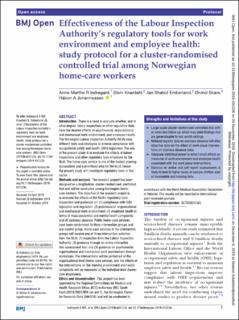| dc.description.abstract | Introduction There is a need to evaluate whether, and to what degree, labour inspections or other regulatory tools have the desired effects on psychosocial, organisational and mechanical work environment, and employee health. The Norwegian Labour Inspection Authority (NLIA) uses different tools and strategies to enforce compliance with occupational safety and health (OSH) legislation. The aim of the present study is to evaluate the effects of labour inspections and other regulatory tools employed by the NLIA. The home-care service is one of the fastest growing occupations and a prioritised area for the NLIA, hence the present study will investigate regulatory tools in this sector. Methods and analysis The research project has been designed as a longitudinal, cluster-randomised, controlled trial and will be conducted among Norwegian home-care workers. The objective of the research project is to evaluate the effects of the NLIA’s regulatory tools (inspection and guidance) on: (1) compliance with OSH legislation and regulation; (2) psychosocial, organisational and mechanical work environment; (3) employee health in terms of musculoskeletal and mental health complaints; and (4) sickness absence. Public home-care services have been randomised to three intervention groups and one control group. Home-care services in the intervention groups will receive one of three intervention activities from the NLIA: (1) inspection from the Labour Inspection Authority; (2) guidance through an online interactive risk-assessment tool; and (3) guidance on psychosocial, organisational and mechanical work environment through workshops. The interventions will be performed at the organisational level (home-care service), and the effects of the interventions on the working environment and health complaints will be measured at the individual level (home-care employees). | |
